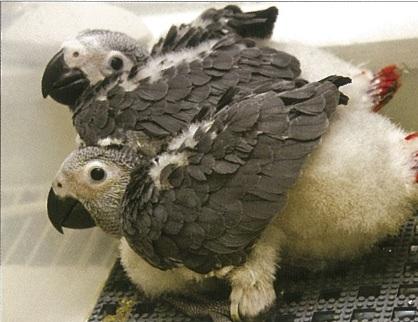Although African greys and Timneh greys seem very similar to one another, many people who have kept both types do identify significant differences between them as companion birds. Timnehs tend to be a little more confident than African greys. Because African greys are more nervous, they are also more inclined to self-pluck their feathers when they are under stress or bored. Since Timnehs seem to be a little more easy-going, they are also less likely to become 'one-person' birds. However, the factor that causes much bigger differences between individual birds' qualities as companion birds is how they were raised. While some wild-caught imported birds may still be sold as 'pet' birds, they remain so nervous of people that they rarely adjust well to life as a 'pet' bird. For this reason, most grey parrots produced for the pet trade are now captivebred.
Captive-bred birds may be hand-reared, parent-reared, or part-parent reared and major differences in the behaviour of these birds when they mature can be caused by the methods used to raise them. Birds which have never seen their own parents and were hand-reared from the day they hatched from the egg can present special problems as adult parrots. These birds often become over dependent on one person and they seem more prone to behavioural problems such as self-plucking. Having missed out on the normal interactions with their own parents, they don't see themselves as parrots, but identify purely with humans for all their needs. They often lack confidence in new situations. These birds are much easier to sell since they show submissive behaviours and are described as 'cuddle tame' when on sale as babies.
Captive-bred birds may be hand-reared, parent-reared, or part-parent reared and major differences in the behaviour of these birds when they mature can be caused by the methods used to raise them. Birds which have never seen their own parents and were hand-reared from the day they hatched from the egg can present special problems as adult parrots. These birds often become over dependent on one person and they seem more prone to behavioural problems such as self-plucking. Having missed out on the normal interactions with their own parents, they don't see themselves as parrots, but identify purely with humans for all their needs. They often lack confidence in new situations. These birds are much easier to sell since they show submissive behaviours and are described as 'cuddle tame' when on sale as babies.
Parent-raised birds are best
Conversely parent-raised greys are less tame as babies, but develop into 'normal' adults and are less likely to experience behavioural problems. They also have more confidence and a degree of independence which renders them less prone to over-bonding with one person. Part-parent raised birds are those which have been raised by their parents for a few weeks, at least until their eyes have opened, but where the process has been completed by hand-rearing. The behaviour of these birds as adults falls somewhere between the other two types and they can do quite well as pet birds. Hand-reared birds are far more commonly available than parent- or part-parent raised birds. However, if you can obtain a parentor part-parent raised bird, these usually make better companion birds.
These birds were raised for the first six weeks
by their own parents, then hand-reared.
by their own parents, then hand-reared.

The prospects of the birds raised by their own parents are better than any bird who is hand-reared and fed by syringe from day one.

The most obvious differences between the two greys are the greater size of the African grey
and this bird's vivid red tail. The smaller Timneh has a duller, maroon-red tail.
and this bird's vivid red tail. The smaller Timneh has a duller, maroon-red tail.